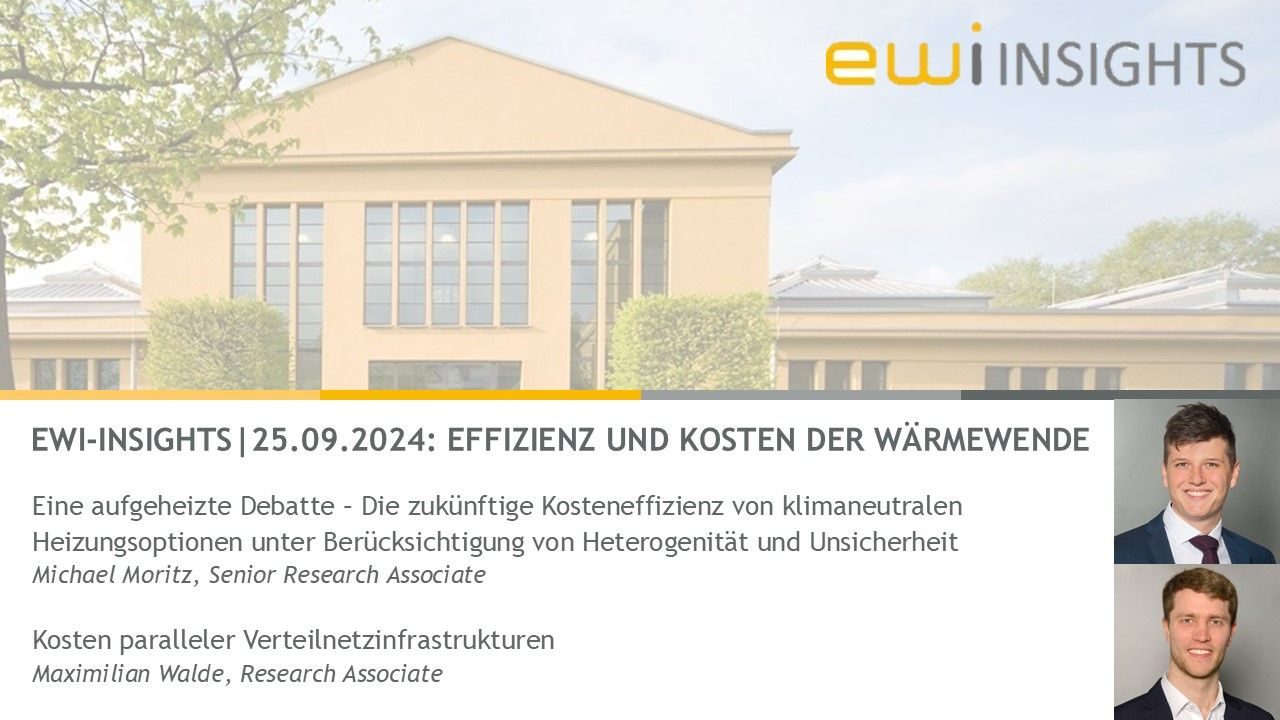
As part of the EWI Insights webinar series, researchers Michael Moritz and Maximilian Walde presented the results of two recent publications on the cost efficiency of climate-neutral heating options and the costs of parallel distribution grid infrastructures for heat supply. The event was moderated by Philip Schnaars.
The two publications presented show on the one hand that the development of infrastructure for heating with heat pumps is probably the most cost-effective option for climate-neutral heating. Large heat pumps with heating networks can offer long-term cost advantages over decentralized heat pumps. On the other hand, decentralized heat pumps could benefit in the short term due to the incomplete utilization of heating networks and the parallel operation of existing distribution network infrastructures. The construction of new heating networks is associated with high investment costs. The short-term hurdles in financing and implementation can be insurmountable for individual municipalities and suppliers, which means that long-term cost benefits cannot be exploited.
In the first part of the event, Michael Moritz, Senior Research Associate at the Institute of Energy Economics at the University of Cologne (EWI), explained which heating technologies could be cost-effective in a future climate-neutral energy system based on their full costs. The results presented are part of a case study for Germany from the new EWI working paper “A heated debate – The future cost-efficiency of climate-neutral heating options under consideration of heterogeneity and uncertainty” by Michael Moritz, Berit Hanna Czock and Oliver Ruhnau. Uncertainties in future energy, technology and infrastructure costs as well as heterogeneity in settlement types and buildings were taken into account. “Investment decisions in heat supply infrastructure need to be made early, as the transition to new infrastructure can take many years. It is therefore important to take into account the uncertainties of future cost developments when making these investment decisions,” said Moritz.
Several conclusions can be drawn from the case study. For example, the decision between decentralized and centralized heat pumps in urban areas should be the focus of municipal heat planning. The working paper also shows that hydrogen boilers can be economically viable in rural and village settlements if hydrogen were to become relatively cheap in the future, but given the high uncertainty about the future price of hydrogen and hydrogen grid costs, hydrogen boilers currently appear to be a riskier option than heat pumps. These are less affected by rising energy and grid costs due to their high efficiency. Synthetic natural gas does not appear economical in the analysis due to its high production costs, although it could use the existing infrastructure in the short term.
Maximilian Walde, Research Associate at the EWI, presented a different perspective on the heating transition. The second part of the webinar dealt with the costs of building and operating parallel distribution grid infrastructures for heat supply. A special focus was placed on the cost-effective transformation of distribution grid infrastructures by taking existing infrastructures into account. The results come from the recently published EWI analysis “Kosten paralleler Verteilnetzinfrastrukturen” by Tobias Sprenger, Maximilian Walde, Stephan Terhorst and Cordelia Frings. In this analysis, the so-called grid usage costs for district heating, hydrogen and electricity distribution grids were calculated and considered depending on the degree of utilization. “Focusing on grid usage costs, it can make sense to use existing distribution grid infrastructures until the end of their service life,” explained Walde.
The analysis shows that, in order to cover the total heat demand, using the existing infrastructure as far as possible and avoiding expansion leads to the lowest grid usage costs. The construction of new infrastructure only makes sense if other distribution grid infrastructure can be decommissioned in the long term in order to achieve the highest possible degree of utilization and thus lower grid usage costs. In all types of settlements examined, the analysis shows electricity and hydrogen grids with significantly lower grid usage costs than district heating. Supplying the heat demand via the electricity infrastructure appears to make particular sense when heat line densities are low or the costs of converting the natural gas grid are uncertain. Despite high grid usage costs, a supply via district heating could make sense when considering all costs, as was shown in the first part of the event.
The online workshop series EWI Insights has been held around four times a year since 2020 and is aimed at experts from business, science and politics who are interested in scientific findings from the world of energy. EWI researchers offer insights into the institute’s current studies and analyses. Information on current EWI events can be found here.